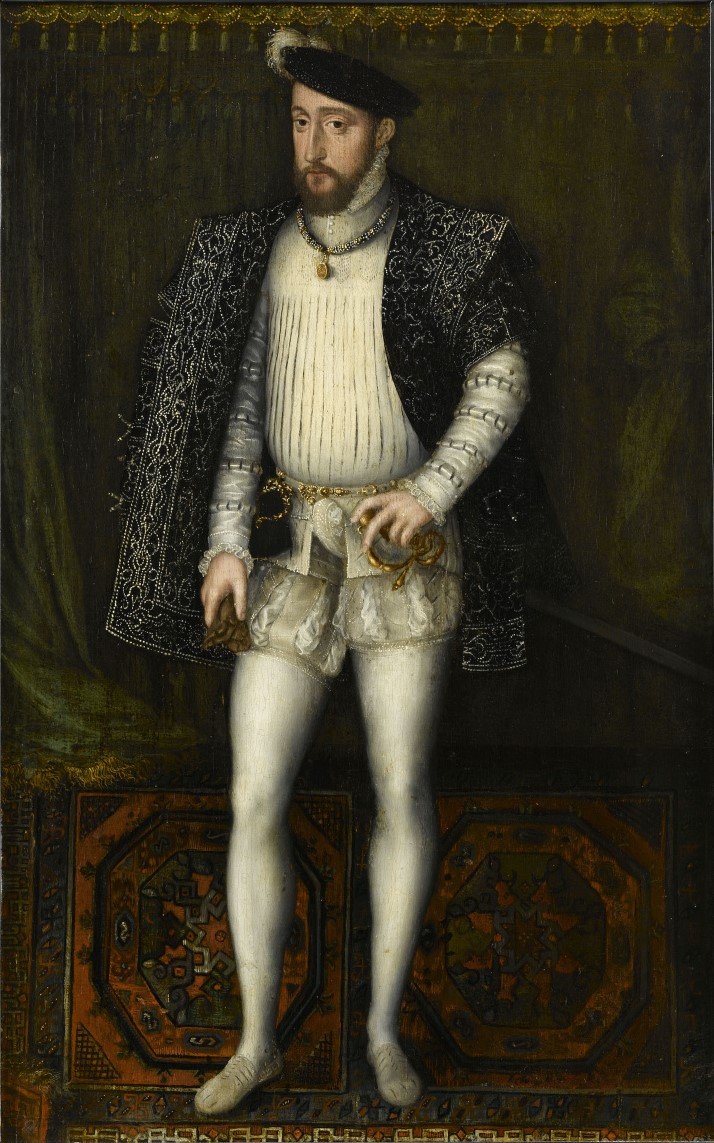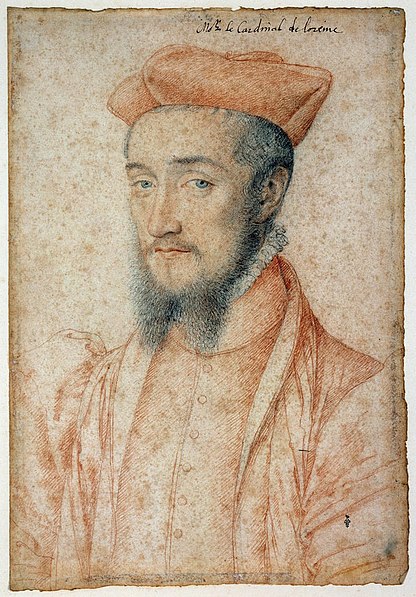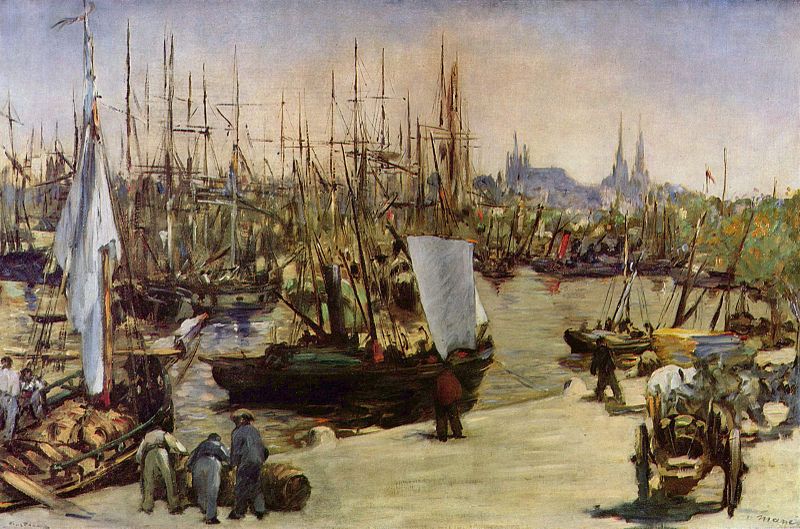 |
| Henri II |
At the end
of January 1547 news arrived that Henry VIII had died. The king was pensive at
the news. Cardinal du Bellay wrote;
‘This death occasioned the
king much sorrow…..because they were almost of an age, and of the same
constitution; and he feared that he must soon follow him. Those, moreover, who
were about his person perceived that from that time he became more pensive than
before.’[i]
François’
health had not been good over Christmas and New Year and celebrations at the
French court had been muted. In February François, who had been staying at the chateau de la Roche-Guyon, set out for Paris for a memorial
service for his erstwhile enemy and rival.
François
fell ill of what is believed to be a urinary tract infection at Rambouillet. An abscess in his stomach, which he
had had for many years, also reopened[ii].
Henri was recalled from the Chateau d’Anet[iii] where he was staying with Diane, to
meet with his father who knew he was dying.
Francois died on Henri’s 28th
birthday, 31st March and on that day Henri ordered a triple funeral
for his father and two brothers[iv].
The funeral took place on 21st May at the Abbey of Saint-Denis[v]; Henri commissioned a tomb for his
father from the architect Philibert de l’Orme.
 |
| Rheims Cathedral |
Henri
entered Paris on the 16th June and the city went wild. The
celebrations were marred by a burning of heretics at which Henri was present.
His sleep was troubled for weeks after the event. Henri was crowned king on
28th July 1547 at Rheims Cathedral[vi]. Henri’s accession was followed by a
widely expected palace revolution. The Duchesse d’Étampes had known for a while that her
time at the top was limited; Henri had never forgiven her for the Peace of Crépy which could have been so damaging
to his interests save for the death of his brother.
Change of Favourites
.jpg) |
| Anne de Montmorency |
Although not
as intelligent nor as intellectual as his father[vii],
Henri had plenty of common sense. He was interested in architecture and was to
use the arts to project his authority. One of his first acts as king was the
recall of Montmorency as President of the King’s Council. François had advised
Henri not to recall Montmorency when father and son met on 20th
March 1547. He also allegedly advised his son not to give power to the Guise
family;
‘Whose aim was to strip him
and his children to their doublets and his people to their shirts.’[viii]
The warning
came far too late; François de Guise had long been influential with Henri as
one of his friends and supporters throughout his years as the despised spare
prince and then the unloved Dauphin. François also advised Henri not to allow
himself to be ruled by a woman as his father had been; another warning that
Henri ignored to the detriment of his reign.
 |
| Chateau de Chenonceaux |
The Duchesse
d’Étampes was
wildly unpopular with the people of France and feared to appear in public. She
was forced to disgorge the jewels given to her by François which Henri promptly
gave to Diane whom he had recalled to court along with Montmorency, Perhaps
because his father had asked him to protect the Duchesse d’Étampes, Henri did not imprison his
father’s former favourite for colluding with Charles V in 1544, but allowed her
to retain what was left of her lands after a number of her properties were
returned to the crown.
Diane was
made Duchesse de Valentinois with a grant of lands and given the Chateau de Chenonceaux[ix]. She was now the dispenser of favours, taking
over from where d’Étampes left off; Henri discussed matters of state with her every
afternoon. At forty eight Diane dominated the twenty seven year old king.
Every bit as
unscrupulous with favours as the old favourite, Diane had her son-in-law Robert
de la Marck, Duke of Bouillon[x] made a Marshall of France and a
royal councillor. Three of her nephews were made bishops within two years of
Henri’s accession. Her hitherto scrupulously held reputation for purity waned
as Diane’s reputation for avarice grew.
The New Régime
 |
| Cardinal de Lorraine |
Among the
newcomers to the royal council were the heir to the Guise family dukedom,
François and his brother Charles who was Archbishop of Rheims[xi]. Backed by Diane, within months of
their appointment as royal counsellors François was made a duke and Charles was
made a cardinal[xii].
Many of the heads of the administrative branch of government were changed, one
allegedly for disparaging Diane de Poitiers’ looks.
In 1547, as
the English threatened France’s ally Scotland, it was agreed that the infant queen
Mary[xiii] would marry the Dauphin François, In
August 1548 the infant princess was sent by her mother Marie de Guise to France to keep her safe from the English invaders. She
was collected by a French fleet that returned to France the long way round via
Ireland. She landed in Brittany and Henri greeted her with jubilation;
‘France and Scotland are now
one country’[xiv]
he declared
as French troops helped man Scottish fortresses against the invaders from the
south. Mary charmed the French court including the king who frequently wrote to
Marie de Guise with news of Mary’s new life. On 12th November 1547
Queen Catherine was brought to bed of another girl child, Claude.
Henri was
unable to forget or forgive the English hold on Boulogne and in 1549 took steps
to return the city to his kingdom. In August Henri declared war on England[xv],
taking advantages of revolts in England; he led his army in person to attack Boulogne.
When the Earl of Warwick became protector of the realm, for
the boy king Edward, he agreed to hand Boulogne back to
the French crown in return for a payment of 400,000 crowns, a much lesser sum
than that agreed between François and Henry VIII.
A Question of Salt
 |
| Cognac |
Having dealt
with the English Henri then wished to turn his attention to the Holy Roman
Emperor; he had never forgiven Charles for his treatment when a hostage in
Spain. Instead he was faced with a tax rebellion in western France. François I
had decided on changes it the gabelle (salt tax) but had not put the
changes in place; that was left for Henri to do and the peasants rose up
against the hated tax collectors.
4,000 rebels
defeated the government troops in the Angoumois region, whose governor appealed for aid to Henri d’Albret Governor of Guyenne. At Cognac the receiver of the tax was cruelly
murdered and thrown into the river. The rebels captured Saintes and then Cognac itself as the
rebellion spread like wildfire.
 |
| Bordeaux |
The revolt
reached Bordeaux, whose citizens were exempt from the
gabelle but were dissatisfied at an
infantry tax imposed upon them. On 21st August d’Albret’s lieutenant
was lynched as he tried to negotiate with the local dignitaries. Henri decided
that punishment was the order of the day. He appointed François de Guise and
Montmorency to deal with the rebels.
Montmorency
arrived in Bordeaux on 20th October with 10,000 troops who disarmed
the citizens and confiscated the city’s artillery and stock of gunpowder. The
local parlement was dissolved and on
6th November Bordeaux was deprived of its privileges, rights and
exemptions forever. The costs of the expedition were to be paid by the city
along with a fine of 20,000 livres[xvi].
About 150
people were executed for their alleged involvement in the rebellion.
Montmorency then took the fight out into the surrounding countryside where the
leaders were rounded up and put to death, some with extreme cruelty. In
September 1549 Henri restored the previous tax system, realising that the gabelle was ‘odious to the people’.
Bibliography
Martyrs and
Murderers – Stuart Carroll, Oxford University Press 2009
Catherine de
Medici – Leonie Frieda, a Phoenix Paperback 2003
Charles V –
Harald Kleinschmidt, Sutton Publishing 2004
French
Renaissance Monarchy – RJ Knecht, Longman Group 1996
The Rise and
Fall of Renaissance France – RJ Knecht, Fontana Press 1996
Catherine
de’ Medici – RJ Knecht, Pearson Education Ltd 1998
A History of
France – David Potter, The MacMillan Press 1995
Prince of
the Renaissance – Desmond Seward, MacMillan Publishing 1973
Emperor
Charles V – James D Tracey, Cambridge University Press 2010
Henri II – H
Noel Williams, Methuen and Co 1910 (reprint 2016)
[i]
Henri II - Williams
[ii]
Treated with Chinese Wood – a variety of Euphorbia, (the sap of which contains alkaloids poisonous to humans)
and, on the advice of Barbarossa, Quicksilver
pills (believed to be efficacious in the treatment of syphilis) which François
was not suffering from
[iii]
Inherited by Diane from her husband Louis de Brézé
[v]
Traditional burial place of the kings of France; for details of the ceremonies after
the king’s death see Knecht, The Rise and Fall of Renaissance France pp234-5
[vi]
Where kings of France were coronated
[vii]
François set up Lecteurs Royaux, which later became the Collège de France and his art
collection became the nucleus of the Louvre museum
[viii]
Catherine de Medici - Frieda
[ix]
In 1555 Diane was to use de l’Orme to design a bridge from the chateau to the
far bank of the Cher
(in the Loire valley).
The chateau was taken from her by Catherine de’ Medici, as regent for her son
François, when Henri died
[xii]
The strength of the Guise family relied on cohesion among family members and
deference to the senior member of the family; it was to take them almost to the
pinnacle of power in France
[xiv]
The Rise and Fall of Renaissance France - Knecht
[xvi]
In 2015 the relative: historic standard of
living
value of that income or wealth is £10,510.00 labour earnings of that income or wealth is
£106,500.00 economic status value of that income or wealth is £365,700.00 economic power value of that income or
wealth is £4,443,000.00 www.measuringworth.com
sometimes repealling a really unpopular tax is the act of a wise man, and it takes some strength of character to do so
ReplyDelete